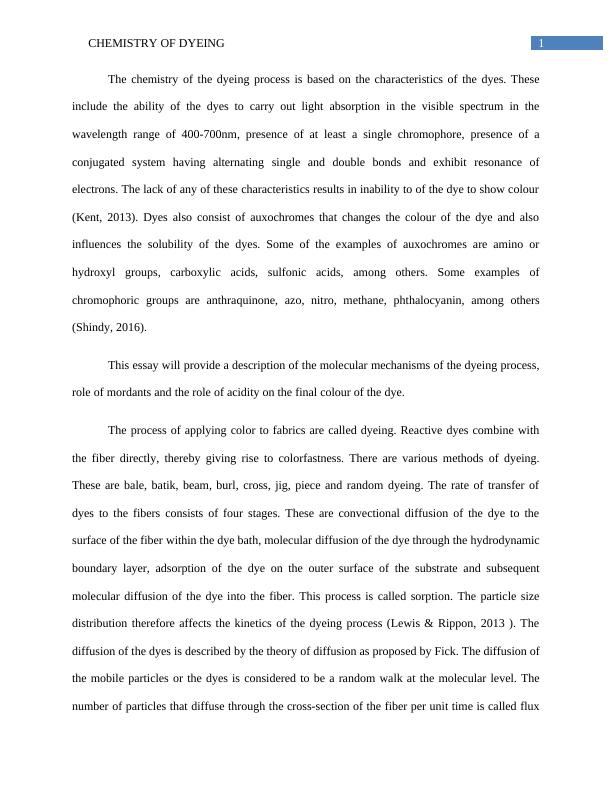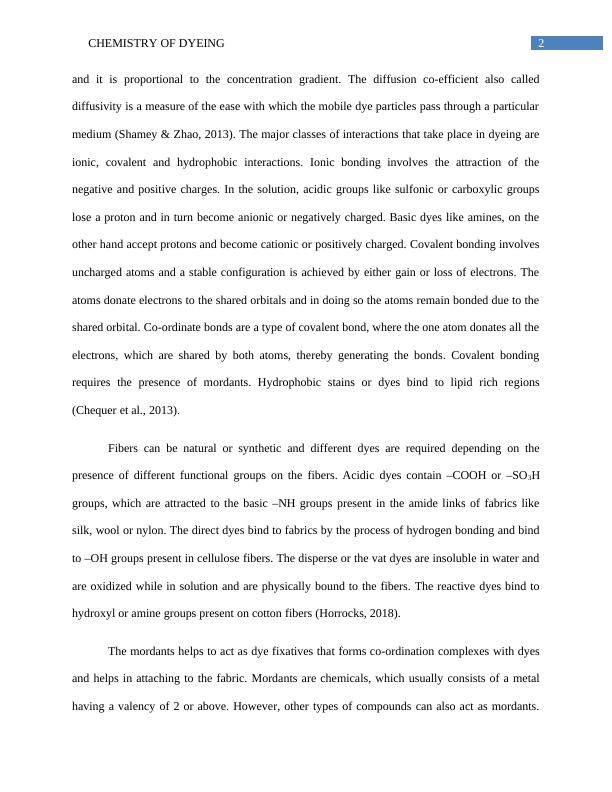Ask a question from expert
Report on Chemistry of the Dyeing Process
7 Pages1846 Words331 Views
Added on 2020-04-15
Report on Chemistry of the Dyeing Process
Added on 2020-04-15
BookmarkShareRelated Documents
Running head: CHEMISTRY OF DYEINGCHEMISTRY OF DYEINGName of the StudentName of the UniversityAuthor Notes

1CHEMISTRY OF DYEINGThe chemistry of the dyeing process is based on the characteristics of the dyes. Theseinclude the ability of the dyes to carry out light absorption in the visible spectrum in thewavelength range of 400-700nm, presence of at least a single chromophore, presence of aconjugated system having alternating single and double bonds and exhibit resonance ofelectrons. The lack of any of these characteristics results in inability to of the dye to show colour(Kent, 2013). Dyes also consist of auxochromes that changes the colour of the dye and alsoinfluences the solubility of the dyes. Some of the examples of auxochromes are amino orhydroxyl groups, carboxylic acids, sulfonic acids, among others. Some examples ofchromophoric groups are anthraquinone, azo, nitro, methane, phthalocyanin, among others(Shindy, 2016). This essay will provide a description of the molecular mechanisms of the dyeing process,role of mordants and the role of acidity on the final colour of the dye. The process of applying color to fabrics are called dyeing. Reactive dyes combine withthe fiber directly, thereby giving rise to colorfastness. There are various methods of dyeing.These are bale, batik, beam, burl, cross, jig, piece and random dyeing. The rate of transfer ofdyes to the fibers consists of four stages. These are convectional diffusion of the dye to thesurface of the fiber within the dye bath, molecular diffusion of the dye through the hydrodynamicboundary layer, adsorption of the dye on the outer surface of the substrate and subsequentmolecular diffusion of the dye into the fiber. This process is called sorption. The particle sizedistribution therefore affects the kinetics of the dyeing process (Lewis & Rippon, 2013 ). Thediffusion of the dyes is described by the theory of diffusion as proposed by Fick. The diffusion ofthe mobile particles or the dyes is considered to be a random walk at the molecular level. Thenumber of particles that diffuse through the cross-section of the fiber per unit time is called flux

2CHEMISTRY OF DYEINGand it is proportional to the concentration gradient. The diffusion co-efficient also calleddiffusivity is a measure of the ease with which the mobile dye particles pass through a particularmedium (Shamey & Zhao, 2013). The major classes of interactions that take place in dyeing areionic, covalent and hydrophobic interactions. Ionic bonding involves the attraction of thenegative and positive charges. In the solution, acidic groups like sulfonic or carboxylic groupslose a proton and in turn become anionic or negatively charged. Basic dyes like amines, on theother hand accept protons and become cationic or positively charged. Covalent bonding involvesuncharged atoms and a stable configuration is achieved by either gain or loss of electrons. Theatoms donate electrons to the shared orbitals and in doing so the atoms remain bonded due to theshared orbital. Co-ordinate bonds are a type of covalent bond, where the one atom donates all theelectrons, which are shared by both atoms, thereby generating the bonds. Covalent bondingrequires the presence of mordants. Hydrophobic stains or dyes bind to lipid rich regions(Chequer et al., 2013). Fibers can be natural or synthetic and different dyes are required depending on thepresence of different functional groups on the fibers. Acidic dyes contain –COOH or –SO3Hgroups, which are attracted to the basic –NH groups present in the amide links of fabrics likesilk, wool or nylon. The direct dyes bind to fabrics by the process of hydrogen bonding and bindto –OH groups present in cellulose fibers. The disperse or the vat dyes are insoluble in water andare oxidized while in solution and are physically bound to the fibers. The reactive dyes bind tohydroxyl or amine groups present on cotton fibers (Horrocks, 2018). The mordants helps to act as dye fixatives that forms co-ordination complexes with dyesand helps in attaching to the fabric. Mordants are chemicals, which usually consists of a metalhaving a valency of 2 or above. However, other types of compounds can also act as mordants.

End of preview
Want to access all the pages? Upload your documents or become a member.
Related Documents
Biology Study Materiallg...
|9
|872
|56